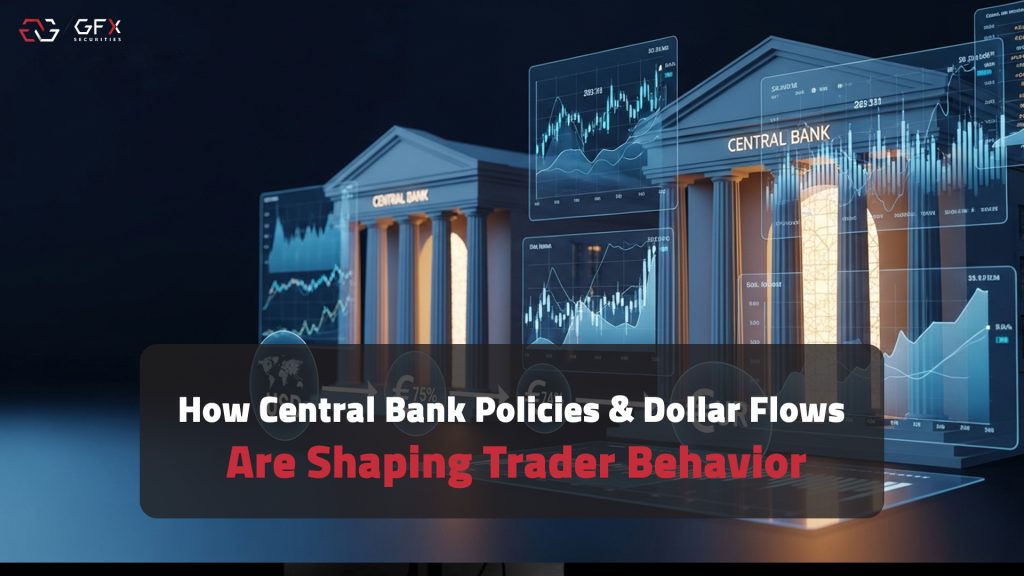
How to Master Forex Trading in 2025:
Powered by GFX Securities
Introduction
The forex market in 2025 is moving faster than ever. With shifting central bank policies, rising volatility in global markets, and changing trader expectations across platforms like TradingView, staying ahead requires more than just chart-reading. Forex traders today must understand how monetary policy, liquidity flows, and market sentiment shape currency movements — especially for major pairs like EUR/USD, USD/JPY, and GBP/USD.
Whether you’re an experienced trader managing a professional account or just beginning to explore forex with your first demo account, the market right now offers both opportunities and risks. The key difference between those who benefit and those who struggle is simple:
Understanding how the global financial system is changing.
In this article, we break down:
- Why central banks hold the real power behind currency trends
- How dollar strength or weakness impacts traders every day
- What the latest macro trends mean for traders using leverage
- Practical strategy guidance for navigating today’s forex environment
- How platforms like GFX help traders stay ahead of volatility
Let’s break it down clearly and strategically.
1. Central Banks Are Driving Market Sentiment
In global forex markets, central banks are the single strongest force. Every time the U.S. Federal Reserve, European Central Bank (ECB), Bank of England (BoE), or Bank of Japan (BoJ) changes policy — the entire market reacts.
Why?
Because central banks influence:
Factor
Market Impact
Interest Rates
Determines attractiveness of currency
Liquidity
Influences market volatility and volume
Inflation Guidance
Signals forward monetary conditions
Economic Outlook
Shapes sentiment and risk-taking behavior
Example:
When the Federal Reserve hints at interest rate cuts:
→ The dollar tends to weaken
→ Euro and Gold often benefit
→ Stock markets gain momentum
→ Traders shift from defensive positioning to high-risk setups
When the Fed signals tightening:
→ The dollar usually strengthens
→ Emerging market currencies face pressure
→ Commodities like oil and copper decline
Knowing these dynamics allows traders to anticipate price action, not simply react to it.
2. The Dollar Still Dominates the Market
More than 88% of global forex transactions involve the U.S. dollar, according to BIS market data.
Why does the dollar dominate?
It remains the global reserve currency
Global commodities (oil, metals, etc.) are priced in USD
International companies settle trade contracts in dollars
Investors move to USD during financial uncertainty
This means:
Where the dollar goes, the market follows.
Current Trend (2025 Scenario)
If inflation stays elevated → The Fed delays cuts → Dollar strengthens
If economic slowdown intensifies → Fed cuts sooner → Dollar weakens
Impact on Traders
| Pair | When Dollar Weakens | When Dollar Strengthens |
|---|---|---|
| EUR/USD | Likely rises | Likely falls |
| GBP/USD | Likely rises | Likely falls |
| USD/JPY | Likely falls | Likely rises |
| USD/CHF | Falls | Rises |
Mastering the dollar is mastering forex trading.
3. The Euro and Market Sentiment
The euro remains the second-most traded currency in the world.
It reflects:
EU business confidence
European Central Bank interest rates
Economic performance of major EU members (Germany, France, Italy)
Geopolitical stability
When EU data shows manufacturing recovery → Euro strengthens.
When Germany slows down → Euro weakens.
The EUR/USD remains one of the most liquid and efficiently priced pairs on TradingView, which is why many traders use it to:
Backtest technical strategies
Identify trend reversals
Develop consistent risk management habits
4. The Role of Leverage and Risk
Leverage is one of the most powerful tools in forex — and also the most dangerous.
When used correctly:
✅ It amplifies gains
✅ Supports strategic scaling
✅ Helps traders take advantage of short-term volatility
When used poorly:
❌ It magnifies emotional decision-making
❌ Leads to forced liquidation
❌ Can wipe an account in minutes
Golden Rule:
Always size your position based on risk percentage — not profit expectation.
Example:
If a trader risks 1% of account balance per trade, they remain sustainable.
If they risk 20%, they’re gambling — not trading.
5. Why Traders Use TradingView in 2025
Modern forex traders rely heavily on TradingView because:
It provides real-time charting tools
You can compare multiple currency pairs simultaneously
It integrates community trade ideas and global sentiment
It supports automated alert setups
Professional traders combine TradingView analysis with low spread execution accounts provided by regulated brokers such as GFX Securities.
This allows:
Faster response times
Better entries/exits
Reduced slippage during volatility
6. Why Opening a Trading Account with a Regulated Company Matters
A regulated broker protects traders by offering:
| Benefit | Why It Matters |
|---|---|
| Segregated client funds | Your money stays separate from company finances |
| Transparent pricing | You see real market spreads, not artificial ones |
| Reliable liquidity | Execution during high volatility |
| Legal protection | Safeguards your withdrawals and deposits |
Choosing a broker isn’t just about spreads — it’s about trust and long-term sustainability.
7. Key Strategies for Forex Traders in 2025
Strategy 1: Trade With Trend Confirmation
Use moving averages + market structure shifts + volume indicators.
Strategy 2: Leverage News and Calendar Events
Major news creates volatility. Plan entries before → exit partial afterward.
Strategy 3: Risk-Based Position Sizing
Never risk your account — protect it.
Final Thoughts
The forex market is evolving rapidly. The traders who succeed now are those who:
Understand central bank policy
Track dollar flows
Use leverage responsibly
Apply disciplined analysis
Stay informed — not emotional
With secure trading accounts, strong market tools, and deep liquidity access, GFX Securities provides a platform built for long-term trading success.


